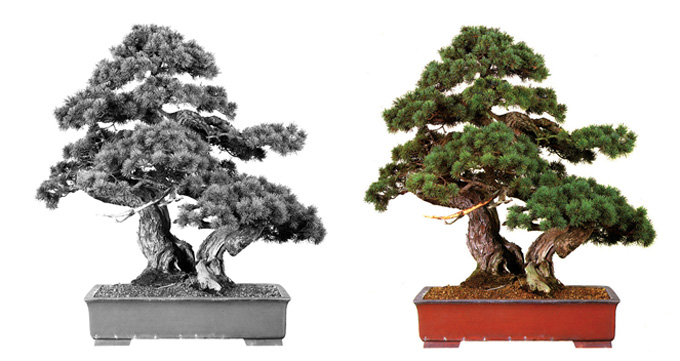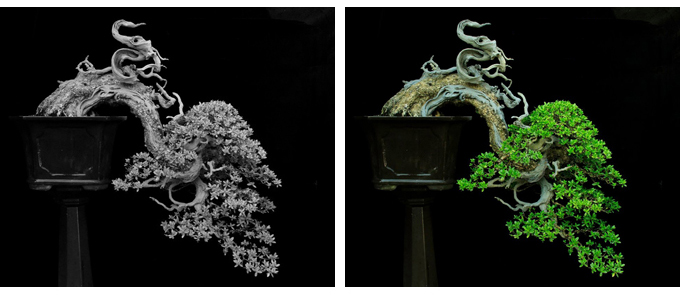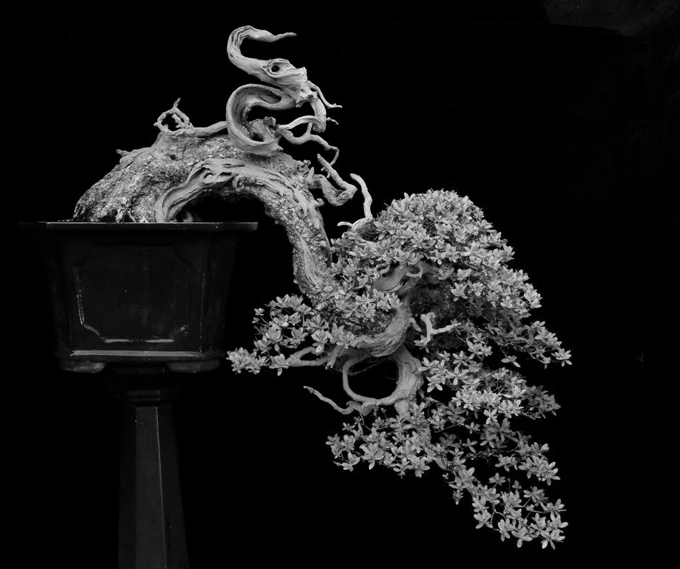 Japanese white pine. You can find the color version of this tree on the cover of our Masters’ Series Pine book and on the cover of Bonsai Today issue number 2. The black and white version is the same image with the color photoshoped out.
Japanese white pine. You can find the color version of this tree on the cover of our Masters’ Series Pine book and on the cover of Bonsai Today issue number 2. The black and white version is the same image with the color photoshoped out.
Black and white?
I don’t have any answers, though there does seem to be something compelling about a good black and white photo. Maybe the stark quality of black and white highlights features that we might otherwise miss. Or…?
 Here’s a good one from flickr. It’s titled Black and white bonsai tree, The Huntington library Japanese garden. My best guess is that it’s a Shimpaku juniper grafted onto San Jose stock. I’ll even go a step further and guess that it originally came from Chikugo-en, Mas Ishii’s and his son Gary’s bonsai nursery.
Here’s a good one from flickr. It’s titled Black and white bonsai tree, The Huntington library Japanese garden. My best guess is that it’s a Shimpaku juniper grafted onto San Jose stock. I’ll even go a step further and guess that it originally came from Chikugo-en, Mas Ishii’s and his son Gary’s bonsai nursery.
 This is the tree that we featured in our last post. It’s Pemphis acidula that’s called Snake Dance. The bonsai artist is Gede Merta. The black & white version was done in photoshop.
This is the tree that we featured in our last post. It’s Pemphis acidula that’s called Snake Dance. The bonsai artist is Gede Merta. The black & white version was done in photoshop.
 Here’s the black & white full sized so you can get a better look.
Here’s the black & white full sized so you can get a better look.
 This one is titled Hangyoku with her bonsai tree (1905). You can get a pretty good feel for just how far bonsai has come in the last hundred years. You can also compare the colorized version with the black & white photo. I found the colorized version on facebook (where else?) and removed the color in photoshop for the black & white version.
This one is titled Hangyoku with her bonsai tree (1905). You can get a pretty good feel for just how far bonsai has come in the last hundred years. You can also compare the colorized version with the black & white photo. I found the colorized version on facebook (where else?) and removed the color in photoshop for the black & white version.
 These two (and some other) photos by Morten Albek are what got me thinking about the value of black and white photos.
These two (and some other) photos by Morten Albek are what got me thinking about the value of black and white photos.
B&W does sometimes bring out features that our eyes didn’t notice before. That’s what makes it a good design tool.
During the punic wars, when I was in college studying photography, … Freshman and Sophomore students were only permitted to work in black and white. It wasn’t until the Junior year that they were permitted to enroll in color photographic courses. The psychology was that while color adds a great deal to a photo, it can also be a great distraction from the more important things a photographer needs to learn such as composition, use of light and shadow, texture, lighting, manipulation of depth of field, etc, etc. First and second year students needed to master these aspects of the photographic art and in the beginning, color was considered too much of a “distraction” for beginners to have to deal with.
All to often people convert their color images to black and white and feel that they turned a ok picture into something better. In my opinion black and white photography takes a much greater understanding of light. I agree that a good black and white photo would highlight things that would otherwise be missed. I think it has to do with creating a balanced overall image (light, contrast, tonal range) would add light detail to areas otherwise lost in shadow. As is displayed with your examples. The picture of the shimpaku picks up a lot of detail but the picture of the pemphis becomes flat. I think this is an interesting topic that delves into another art form. Light and composition make a photo and sometimes what works in color doesn’t necessarily convert to black and white without considerable effort (photoshop). But hey that is just my opinion. Cool post.
As a photographer black and white photos show contrasts and great texture. Black and white photos are not what everyone like. It like a bonsai, it the eye of the beholder.
As a photographer black and white photos show contrasts and great texture. Black and white photos are not what everyone like. It like a bonsai, it the eye of the beholder.
In traditional film photography black and white films were available that had very distinct contrast and gray response that color film often did not. That is why many of the older photos showed such exquisite detail. In modern digital photography I think the closest you can get to that range of contrast is with HD techniques, using multiple exposures of the same subject, but those are usually used with contrasty colors for eye candy. I think a serious photographer that was after the older B&W film effect with a good grasp of HD photography would have an avid audience in the bonsai market.